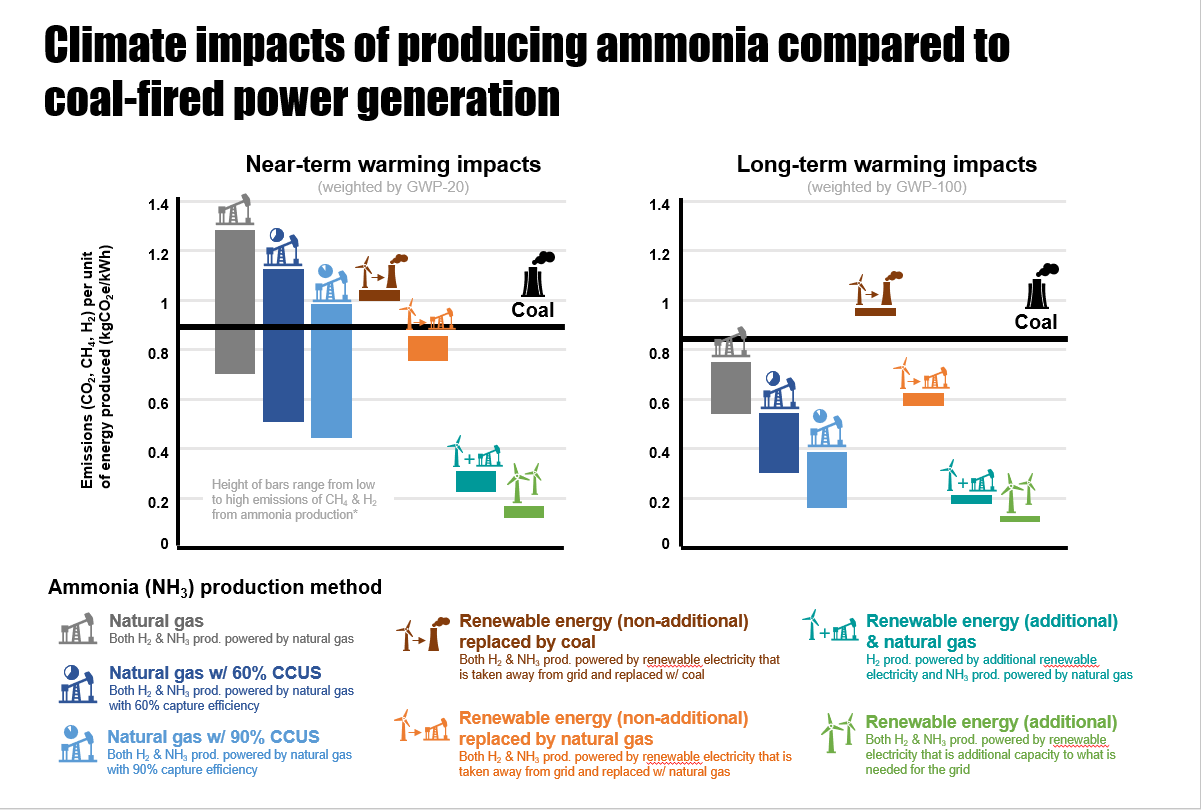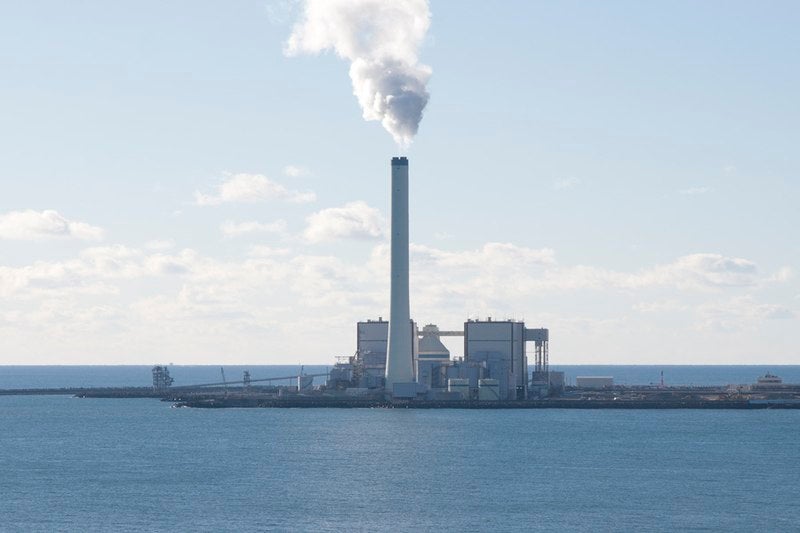By Sofia Esquivel-Elizondo and Ilissa Ocko
Companies are announcing plans to use ammonia to decarbonize the power sector, because they view it as a carbon-free fuel that does not emit carbon dioxide and other carbon-based air pollutants, such as carbon monoxide, when combusted.
But there are serious issues with this strategy, primarily because it doesn’t take ammonia production — which often requires fossil fuels — into account. Depending on how it is made, using ammonia for power generation can increase greenhouse gas emissions and be incompatible with temperature targets. And, even when production is clean, co-firing ammonia can be expensive, dangerous and worsen air quality.
But pursuing ammonia primarily to benefit the climate, when it could make the climate worse, seems to make little sense despite its other issues. So, we did the math to see just how good or bad ammonia production can be for the climate, compared to using coal for power generation.
Why using ammonia in power generation is risky for the climate Click To TweetWarming impacts of ammonia production vs. coal
To determine how much warming is possible, we looked at the near- and long-term warming impacts from emissions of carbon dioxide, methane and hydrogen for seven different ammonia production pathways that covered the full range of dirtiest to cleanest and for best-case and worst-case methane and hydrogen emissions rates (see figure).
Warming impacts from ammonia production depend on the production method, the level of emissions and the timescale of interest because methane and hydrogen emissions (emitted from operational releases and leakage during the production process) are most powerful in the near-term.

* CH4 emissions from natural gas extraction, hydrogen production, and combustion. H2 emissions from hydrogen production (not from compression, liquefaction or distribution)
When we compared the results to the warming impacts from carbon dioxide and methane emissions from a coal-fired power plant, we found that in the near-term, ammonia production can cause 50% more warming or 80% less warming, depending on the production method and emissions rates.
It is clearly not advisable to replace coal with ammonia produced from fossil fuels with high-carbon emissions. It is still risky, even if carbon capture technology is employed and captures 90% of carbon dioxide emissions from hydrogen and ammonia production, because more warming from the ammonia can occur in the near-term than the coal-fired power plant if methane emissions are even moderately high. And, in the long term, this method is still only 50% cleaner than coal with high methane emissions. But it can be 80% cleaner if methane emissions are kept to a minimum.
When renewable electricity is used for both hydrogen and ammonia production, known as e-ammonia, both carbon dioxide and methane emissions can be prevented, providing strong climate benefits from ammonia relative to coal over all timescales. And if hydrogen emissions across its entire value chain are minimized, there are even more climate benefits from ammonia.
But we must be careful not to take away renewable energy needed to decarbonize the power grid. Because if we do, we will need to produce more electricity from coal and natural gas to support the power grid, again ending up in a situation where ammonia production is worse for the climate than coal-fired power plants, this time over all timescales.
So where are all these climate impacts coming from and how can we reduce them?
All ammonia production emits climate-warming gases
There are many ways to make ammonia, and every method emits climate-warming gases to varying degrees.
The conventional method to manufacture ammonia uses the Haber-Bosch process, which combines molecular hydrogen with atmospheric nitrogen and typically uses natural gas as the energy source to do so. And because molecular hydrogen is not readily found in nature, we need to make that, too. Today’s hydrogen production relies almost entirely on natural gas or coal.
Therefore, conventional ammonia production using fossil-based hydrogen generates large amounts of carbon dioxide emissions and other carbon-based air quality pollutants. While carbon capture technologies can reduce carbon dioxide emissions, they won’t help reduce methane emissions.
Methane is the main component of natural gas and can be emitted from leakage, venting and flaring. Methane is a potent greenhouse gas, particularly in the near-term, and can warm the climate at least 80 times more than carbon dioxide over a twenty-year period pound for pound. The extent of methane emissions can be low (less than 1%) or high (more than 3%) depending on the supply pathway.
There are, however, methods to make ammonia and hydrogen without using natural gas. We can use renewably-generated electricity, which would emit near-zero carbon dioxide and methane. But even with this method, we still need to worry about hydrogen.
Hydrogen itself is a leak-prone gas that also has potent near-term warming effects when emitted. In fact, the latest science suggests hydrogen can warm the climate at least 35 times more than carbon dioxide over a twenty-year period pound for pound when it chemically reacts in the atmosphere and subsequently causes other greenhouse gases, including methane, to increase. While no one knows how much hydrogen is emitted from existing infrastructure, estimates suggest it could be as high as 10% across the value chain.
Finally, ammonia itself can lead to increased greenhouse gas emissions because it is naturally converted into nitrous oxide in the environment. This powerful, long-lived greenhouse gas can warm the climate around 275 times more over a 100-year period than carbon dioxide pound for pound.
The bottom line
Overall, the use of ammonia in the power grid — either for co-firing with coal or to burn on its own — is not guaranteed to help us achieve climate goals. In fact, ammonia can be even worse for the climate in the near-term, especially if fossil feedstock and dirty energy sources are used to manufacture it. Any plan that considers its use needs to ensure that ammonia production is as clean as possible and complementary to other clean energy goals.
While ammonia’s climate benefits can be maximized if we are careful and thoughtful in its production and use, the additional concerns raised by experts — such as its toxicity and generation of air pollution — call into question whether it should be pursued in the power sector at all. Clean ammonia and other alternative fuels provide the greatest climate and environmental benefits when used in applications that cannot be directly electrified with renewable energy.
For more information on the methodology and literature behind this analysis, click here.
Research for this blog was done with support from Eriko Shrestha.
